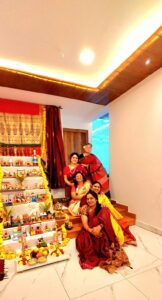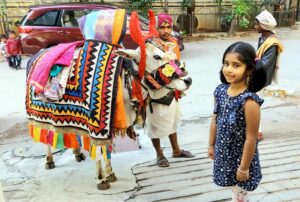
Amalapuram is a coastal village in Andhra Pradesh. (Supplied)
The festival of Sankranthi brings back many fond memories, especially of travelling to my village, Amalapuram, in coastal Andhra Pradesh. Both my grandparents worked in Zilla Parishad schools and my father grew up in this town in East Godavari district.
Weeks before the festivities, our grandparents would make a trunk call to our neighbour’s house, asking us about our travel plans. Sometimes, letters would be exchanged on blue inland covers.
Back in the day, the RTC bus was our means of transport. We would book tickets and board from the Mahatma Gandhi Bus Station (MGBS). As young kids, we would sit by the window, look out and think that the moon and the trees were also travelling with us.
At the crack of dawn, we would witness a different scenery — green paddy fields all around us. I also remember dropping coins into the Godavari River as we crossed over.
Once we arrived at the bus stand, I often noticed many buses with huge bunches of banana leaves tied atop the vehicle. These leaves were going to hotels and markets in cities for sale during the festival.
We would then hire a pull-cart rickshaw. While these rickshaws were seated quite low in Hyderabad, the ones in Amalapuram had higher seats. My grandmother always noted that sitting in a rickshaw in Hyderabad is like sitting on peeta (low and small wooden seating one would use to sit during pooja and meals).
Once we reached our grandparents’ place, we would get a warm welcome from all the neighbours. As a rule, we had to always wash our feet before entering the house.
Dhanur masam starts around mid-December and culminates in Bhogi. Since my grandparents observed this month, the mandatory breakfast was kattu pongal. It is rice cooked with moong dal, cumin seeds, crushed peppercorns and ginger.
But my sister and I would doze off right after breakfast, thanks to the bumpy bus rides.
Sankranthi festival meant a lot of action in these otherwise laid-back towns. Son(s)-in-law (especially newlyweds) would be formally invited to visit. A typical Andhra household would be happily and chaotically making sweets. One sweet that is popular during Sankranthi is the Ariselu.
In anticipation of our arrival, our grandmother used to keep these sweets including noogi jeedi (hardened jaggery syrup with sesame seeds) ready for us. But of course, the one we all waited for was the round, coin-sized, decadent orange cream biscuits from Gopal biscuit company, a famous biscuit baking company. It was a household name in Amalapuram.
On the day of Bhogi, all of us wake up early. It is a custom to use cow dung cakes and burn them with ghee. There are a few villages surrounding Amalapuram that are dedicated to preparing these cakes.
Around 4 am, the entire street used to assemble to light up the celebratory fire, Bhogi Mantalu. Old brooms would be kept aside to be offered in the Bhogi Mantalu, along with other discarded items that are gathered during the cleaning that precedes this season.
Another sight to behold was the colourful muggu (kolam/rangoli) that adorned the entrance of every home. Girls in our neighbourhood would have muggu books filled with instructions on the number of dots to use to make a particular muggu. I used to love helping the neighbour akkas with muggu and filling these muggus with colours.
Macharamma would come to wash our hair with kunkundukaya (shikakai). Our hands and legs would be anointed with oil, and then we’d bathe using sunnipindi (bath powder made of Bengal gram and rice).
What followed this routine is what made me feel like a celebrity.
A Sande Gobemma would be placed in the middle of a big muggu adorning our gate. While Gobemma is a small heap of cow dung adorned with pumpkin flowers, the Sande Gobemma is the central and big one.
I was always made to stand in the centre and as a kid, who was barely three to four years old, I felt important. We would all dance around the muggu singing gobbiyallo, gobbiyallo…
This scene is etched in my memory as one of the best. We continue this tradition with our daughter every year.

Bommala Koluvu (golu), a display of dolls, is an essential part of the three-day Sankranthi celebrations. (Supplied)
Besides this, Bommala Koluvu (golu), a display of dolls is an essential part of the three-day Sankranthi celebrations in many homes in Andhra. We would help our grandmother set up the Koluvu.
By evening, all the kids would assemble to celebrate Bhogi pallu. Flower petals, wild berries, a few coins and black chana are added to a bowl.
Then, this mixture is poured onto each kid’s head with blessings from the elders.
This ritual would be repeated as we visited every neighbour. I vividly remember picking up the change, comfortably ignoring our mother’s warning that they are meant to ward off the evil eye, and not to be picked.
We would then go Koluvu-hopping. One of the houses had tall grass and tiger figurines were placed on it to create a scene of a tiger on the prowl. In another house, there was a working model of a borewell.
Yet another house had a miniature baby in a cradle.
The sound of the nadaswaram of the gandireddu would fill the streets on the day of Sankranthi. A bull would be adorned with beautiful clothes and bells around its feet. We would all gather around and watch the bull in awe!

The sound of the nadaswaram of the gandireddu would fill the streets on the day of Sankranthi. (Supplied)
He would ask the bull to bow down to the head of the family, the women, the kids and ask us to give some old clothes in return. Then the Haridasu would arrive, a person dressed up in saffron like Naradamuni, with a stringed instrument. We would offer alms when he sang praises of Lord Krishna.
No one is allowed to travel on Kanuma, the third day of this festival. We would gather to play Ashta Chemma and Vaikuntapaali. Both of these Indian games are played with shells. While Ashta Chemma, teaches that we might have to sacrifice our own to win, Vaikuntapali (an ancient version of snakes and ladders) taught us death and defeat is inevitable.
It was also customary to eat something made of Minumu (urad dal). Kanuma roju minumu korakali – a bite of urad is a must on Kanuma. On Kanuma day, the muggu is of Ratham/chariot.
The ropes of the chariot are drawn away from the home to indicate that the deities are heading back to their home. Along with the devatas, it was our turn too to return to our homes. With a heavy heart, we would drag ourselves off to Hyderabad again, only to come back during summers.
(Dr Sridevi Dileep is a Textile Engineer with a Doctorate in Materials Science and Engineering. She is a saree connoisseur. Sridevi runs “A Stitch in Time” an enterprise dedicated to customising Indian art. )

May 20, 2024

May 20, 2024

May 19, 2024

May 19, 2024

May 15, 2024

May 14, 2024